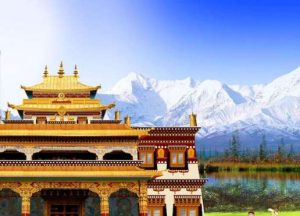Printing blocks housed at the Dege Sutra-Printing House (Tibetan: Dege Parkhang), located in modern-day Sichuan Province, southwestern China, have been recognized as documentary heritage for inclusion in the Asia Pacific regional register of UNESCO’s Memory of the World Programme.
First constructed in 1729, the Dege Sutra Printing House, in Dege County of Garze Tibetan Autonomous Prefecture, in the traditional Tibetan region of Kham, is home to more than 270,000 wooden blocks for printing texts, primarily in Tibetan and Sanskrit. While a majority of the woodcut printing blocks still preserved were carved between the 18th and mid-20th centuries, and cover a broad range of topics from Buddhism and spirituality to history, art, medicine, and astronomy, the collection also includes significant examples of Tibetan literature that date to the 11th century.
These intricate blocks, primarily carved from dense, hard birch wood, have played a key role in the preservation Tibetan literature, culture, and scriptural texts for nearly three centuries.
“For nearly 300 years, generations of craftsmen at the three-story [Dege Parkhang] building have used their exquisite skills to carve scriptures on wooden blocks, and then compiled them into books, making the printing ink and paper themselves,” the Hong Kong-based website Bastille Post Global reported. “The engraving of the printing plates for the Kangyur . . . [the historical Buddha’s teachings as recorded in the Tibetan Buddhist canon] took 100 calligraphers three years and 500 craftsmen five years to complete.”
The Bastille Post Global report also noted that Dege Parkhang had conducted cultural and educational activities to engage young people in their traditional cultural heritage, and had launched foreign-exchange and cooperation programs to promote Tibetan culture around the world.
“These Tibetan classics play a very important role in the study of ancient Tibetan culture,” Tibetan studies expert Yeshe Wonbo was quoted as saying. “Our government will continue to increase investment and provide important support and promotion for our reproduction project, which is crucial for the protection and inheritance of the important documents of the Dege Sutra-Printing House.” (Bastille Post Global)
The decision to include the printing blocks in UNESCO’s Memory of the World Programme—among 20 items successfully inscribed this year—was approved at the 10th General Meeting of the Memory of the World Committee for Asia and the Pacific, which convened on 7–8 May in Ulaanbaatar, Mongolia.
Dege Parkhang is the largest of three major sutra-printing houses in the Tibet, standing alongside Lhasa Sutra-Printing House at Meru Monastery in Lhasa, which was built more than 400 years ago, during the time of the Fifth Dalai Lama, and Lhapuleng Sutra-Printing House at Labrang Monastery in Tibet’s traditional Amdo region, in what is now Gannan Tibetan Autonomous Prefecture in Gansu Province.
“Among an array of other woodblocks, [Dege Parkhang] holds those for the Degé edition of the Kangyur, which was edited by Situ Paṅchen Chokyi Jungne, and the Degé Tengyur, which was edited by Zhuchen Tsultrim Rinchen,” said 84000: Translating the Words of the Buddha, a global nonprofit initiative founded by the renowned Bhutanese lama, author, and filmmaker Dzongsar Khyentse Rinpoche, in a recent announcement shared with BDG.
The Dege Sutra-Printing House was founded by King Tenpa Tsering, ruler of Derge Kingdom, who sponsored the creation of the Degé Kangyur. Although the printing house publishes thousands of other texts to the present day using the traditional woodblock or xylographic printing method, the Kangyur and Tengyur are considered foremost among them, 84000 emphasized.
Dege Printing House is part of the Gonchen Monastery complex, which was founded by Thang Tong Gyalpo (1385–1464). The monastery was completely destroyed during the Chinese invasion of Tibet and subsequently rebuilt in the 1980s.
“The printing house continues to employ ancient techniques without the use of electricity. Approximately 217,000 engraved blocks of scriptures from all Tibetan Buddhist sects, including the Bon tradition, are housed here, with about 2,500 pages produced by hand each day in the traditional manner,” the news website Phayul remarked.
“This printing house is precious. All the classical doctrines of the five major Buddhist sects are kept in it,” the director of Dege Sutra-Printing House, Chen Lin, was quoted as saying in 2016. “It’s a holy place for the whole Tibetan people and of high importance for the country.” (Tibet Vista)
UNESCO’s Memory of the World (MoW) Programme is an international initiative aimed at safeguarding the documentary heritage of humanity against loss and destruction. The Memory of the World Register, launched in 1992, consists a collection of documents, manuscripts, oral traditions, audio-visual materials, and archival records of universal value. Regional lists for the program include records that have impacted five regions in the world.
See more
Dege Parkhang Sutra-Printing House
UNESCO’s Memory of the World (MOW) Regional Register inscribes 20 new items in recognition of human innovation and imagination in Asia-Pacific (UNESCO)
Dege Sutra-Printing House (Tibet Vista)
UNESCO lists Tibetan Dege Sutra-Printing House as China’s contribution to the world (Tibetan Review)
The Dege Sutra-Printing House: A Testament to Tibetan Culture Now Listed by UNESCO (Yarloong)
Derge printing house’s historic printing blocks earn UNESCO recognition (Phayul)
China’s ancient Tibetan sutra-printing house included in UNESCO list (Bastille Post Global)
3 more Chinese items inscribed on UNESCO Memory of the World regional register (News.cn)
Related news reports from BDG
Ancient Korean Buddhist Text to Be Inscribed on UNESCO Memory of the World Register
Two Pavilions at UNESCO-listed Buddhist Mountain Monastery in Korea to be Designated National Treasures
Japan Seeks UNESCO Listing for 1,000-Year-Old Buddhist Documents
UNESCO Lists Korea’s Buddhist Lantern Festival as Intangible Cultural Heritage of Humanity
UNESCO Listing Proposed for Sarnath, Site of the Buddha’s First Sermon
UNESCO Declares Myanmar’s Ancient Buddhist Temple City Bagan a World Heritage Site






















